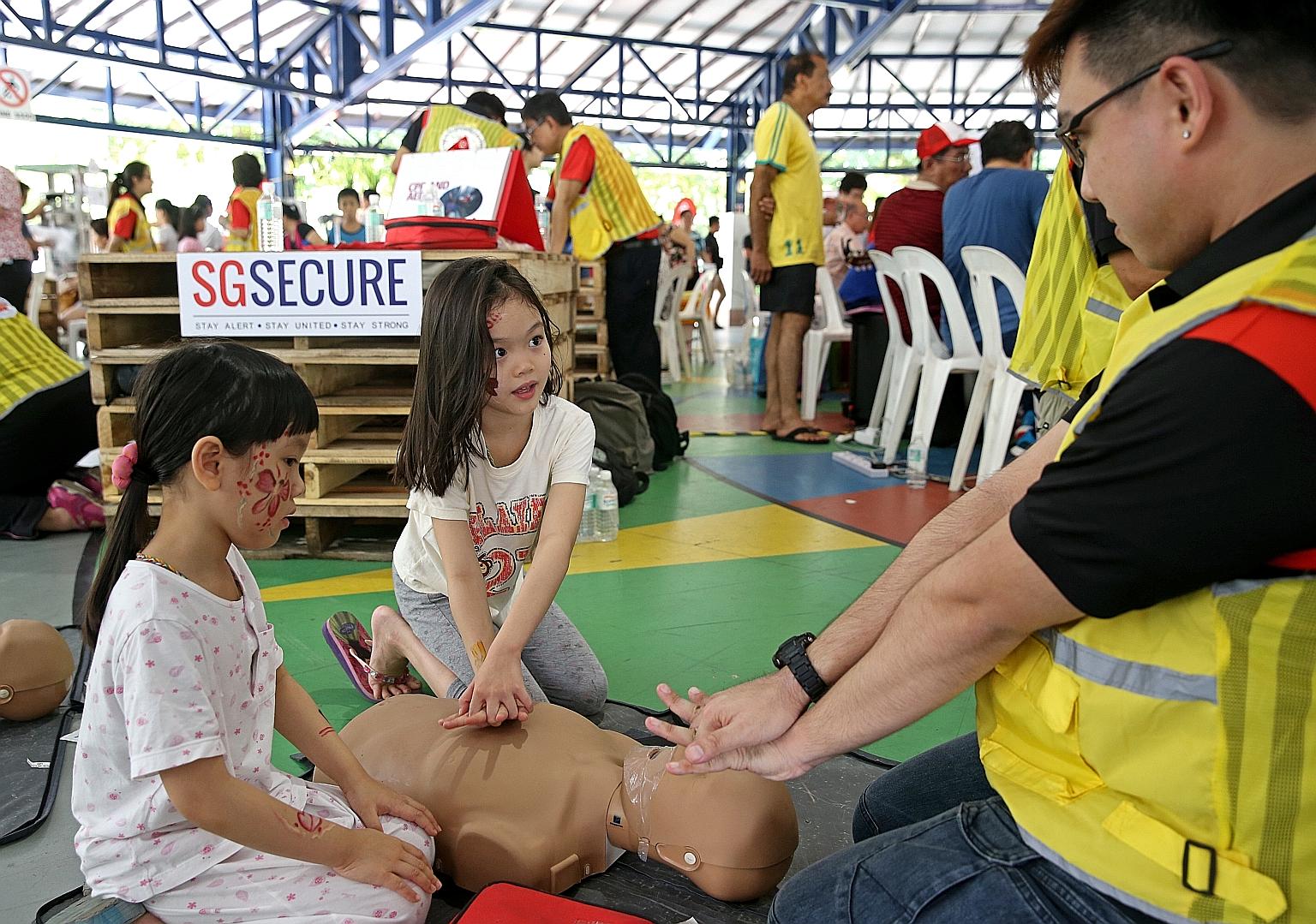More trained in life-saving skills
84,000 trained in CPR last year, up from 32,000 in 2008
Sign up now: Get ST's newsletters delivered to your inbox

Sisters Quek Gek Ling (left), six, and Gek Boon, eight, learning about CPR from Community Emergency Response Team member Adris Chong at a Hougang block in July. There is greater awareness of the benefits of being trained in CPR, and more schools, community centres and firms are teaching it.
ST PHOTO: SEAH KWANG PENG
Felicia Choo
Follow topic:
More people are arming themselves with life-saving skills, even before the launch of a national drive to prepare the public to deal with terrorist threats.
About 84,000 people were trained in cardiopulmonary resuscitation (CPR) last year, nearly thrice as many as the 32,000 in 2008, according to the National Resuscitation Council Singapore.
The jump in numbers follows a greater awareness of the benefits of being trained in CPR, said Professor Venkataraman Anantharaman, chairman of the council.
This is also partly the result of more schools, community centres and companies teaching CPR, as well as the Singapore Armed Forces teaching its recruits such skills, he added.
The greater availability of accredited training centres - from 28 in 2008 to 93 last year - has also helped.
"The more people who learn CPR, the more likely it is they will intervene when someone collapses," said Prof Anantharaman.
"The bystander has the greatest chance of saving the (victim's) life - for every minute of not performing CPR, the chances of survival are reduced by 7 to 10 per cent."
The growth in people trained in CPR comes on the back of the SGSecure drive launched last month to prepare the public against terrorist threats.
Across the island, the People's Association has also introduced CPR and automated external defibrillator (AED) training to residents as well as members of Community Emergency Response Teams.
AEDs are devices used to restart a heart that has stopped beating.
One initiative that has encouraged more people to sign up for CPR courses is the Dispatcher-Assisted first Responder (Dare) programme piloted in 2014.
The one-hour programme teaches a simplified form of CPR not involving mouth-to-mouth resuscitation. Trainees are taught instead to check if the victim is responsive, call 995 and stay on the line with the medical dispatcher to perform CPR and use an AED as directed.
Nearly 36,000 students and teachers from more than 70 schools have taken part in the programme by the Unit for Pre-hospital Emergency Care at the Ministry of Health.
"The programme is targeted at non-medical professionals because it's easier and responders can work with dispatchers to render assistance, rather than performing CPR alone," said Associate Professor Marcus Ong, the unit's medical director. Participants are also encouraged to sign up for CPR certification afterwards , he added.
Based on a study done in 2012 by researchers here including Prof Ong, close to half of trained bystanders are now willing to perform CPR or dispatch-assisted CPR on victims, up from around 20 per cent over the last 10 years. This is crucial as less than 2 per cent of 2,000 out-of-hospital cardiac arrest cases will survive if CPR assistance is not rendered immediately.
Primary 5 pupils have also started theory-based lessons on CPR and using AEDs during physical education (PE) lessons this year.
There are plans to extend this to PE lessons for all Secondary 1 students from next year, after a successful pilot in 15 secondary schools this year.
Temasek Junior College student Luqman Rahman, 17, was inspired to learn CPR skills three years ago after taking part in the Dare programme.
"I wanted to expand my knowledge so that I can be in a better position to help the people who need assistance," he said.
He has put his skills to good use. After downloading the myResponder mobile application which alerts responders to cardiac arrest cases within a 400m radius two years ago, he has responded to 10 cases.

